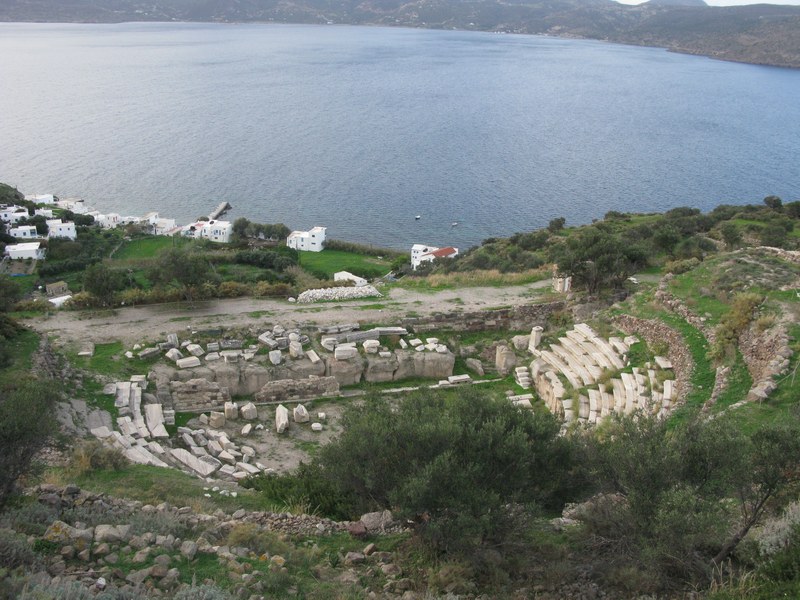
The ancient theater is located in the area where the ancient city of Milos stretches and is partly excavated.
The natural slope of the area was used for the cavea, which has the typical horseshoe shape of ancient Greek theaters. The seven tiers with up to 9 rows of white marble seats have been revealed in the cavea. Each row has four to five seats. The extension of the cavea upwards is not known.
The orchestra is shaped at a depth of about 1.70m. below the level of the diazoma’s slab plates in order to have it function as an arena. The vertical surface of the rock between the level of the arena and the diazoma’s plates was lined with marble slabs.
Traces of foundations, part of a wall, part of the wall-base and scattered architectural members have survived from the stage building. As to its form, the architectural members remind of Asia Minor’s standards.
From the two side retaining walls of the theater, made of local andesite, only the western part has been revealed.
Ancient Theater of Milos
Theater
It is located on the hillside where the ancient city stretches, in an impressive position overlooking the bay of Milos island. The monument is partially excavated. From the excavations to date, the orchestra, part of the cavea, the stage and the western retaining wall have been unveiled.
In 1816 theater plans were drawn by C. Haller von Hallerstein and in 1836 by the architects of the Expédition scientifique de Morée (see bibliography). Photographic documentation, topographical and plan imprints of the monument have been made periodically by the 21st Ephorate of Prehistoric and Classical Antiquities. The photographs and drawings are kept in the Ephorate’s archives.
It is located on the hillside where the ancient city of Milos extends, among the modern settlements of Tripiti and Klima. It is included in teh unbuilt Zone A of Absolute Protection of the ancient city of Milos (Government Gazette 1193 / Β / 19.11.98).
The surviving form of the theater dates back to the Roman era, but it is possible that the original construction of the building dates back to the Hellenistic period.
The ancient theater is located in the area where the ancient city of Milos stretches and is partly excavated.
The natural slope of the area was used for the cavea, which has the typical horseshoe shape of ancient Greek theaters. The seven tiers with up to 9 rows of white marble seats have been revealed in the cavea. Each row has four to five seats. The extension of the cavea upwards is not known.
The orchestra is shaped at a depth of about 1.70m. below the level of the diazoma’s slab plates in order to have it function as an arena. The vertical surface of the rock between the level of the arena and the diazoma’s plates was lined with marble slabs.
Traces of foundations, part of a wall, part of the wall-base and scattered architectural members have survived from the stage building. As to its form, the architectural members remind of Asia Minor’s standards.
From the two side retaining walls of the theater, made of local andesite, only the western part has been revealed.
Both natural causes and extensive stone stealing have caused major problems and damage to the monument.
The ancient theater of Milos was discovered in 1814 and was cleansed in 1836 by the later Bavarian King Ludwig I, who bought it when he was still a successor to the throne and then donated it to his son Otto when he became King of Greece.
From 1990 to 1995, within the framework of the project “Fixing-Restoration of Milos Theater” (funded by IMPs through the PIP of the Ministry of Culture), the 21st EPCA carried out excavation works – during which the orchestra and many architectural members were discovered – as well as small fixing works and interventions to rescue the monument..
In 2009, a restoration study of the ancient theater was carried out in the framework of the 3rd CSF.
Simple visit
The theater has been used in the recent past for music and theater performances, but it stopped to being used in the year 2000, as its condition posed dangers to both viewers and the monument itself.
The project “Promotion of the ancient theater of Milos” has been included in the Operational Program for Crete and the Aegean Islands 2007-2013, implemented by the 21st EPCA. The aim of the project is to rescue the monument from further collapse, preserve and protect it, improve its image and beautify its immediate surroundings, make the visit to the monument safe and create a space of education, the center of cultural activity in Milos.
Ministry of Culture & Tourism / 21st Ephorate of Prehistoric and Classical Antiquities
Ministry of Culture & Tourism / 21st Ephorate of Prehistoric and Classical Antiquities
36.737732°
24.42102°
| Name | Date | Amount (€) |
|---|---|---|
| Diazoma Association | 3.000.00 |
| Expenditure | Date | Amount (€) |
|---|---|---|
| Ancient theater of Milos Αμοιβή Έδαφος Α.Ε. ΤΟΥ 869 | 2.152.50 |